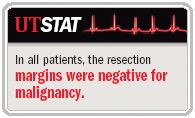Article
Novel laparoscopic partial nephrectomy technique avoids vascular clamping effects
Author(s):
Use of hemostatic hydrodissection and bipolar vessel coagulation appears to be a viable method for avoiding vascular clamping and subsequent renal ischemia while performing laparoscopic or robotic partial nephrectomy.

Key Points

Researchers presented their experience in using this novel technique at the 2007 AUA annual meeting in Anaheim, CA. Their presentation reported results for five patients undergoing laparoscopic partial nephrectomy (LPN) for small exophytic renal masses.
A waterjet device (Helix HydroJet, ERBE USA, Inc., Marietta, GA) was used to selectively hydrodissect the renal parenchyma away from the intra-parenchymal blood vessels. Bipolar cautery (BiClamp, Erbe USA, Inc.) was then used to coagulate these vessels individually. This was all done successfully without renal hilar vascular clamping.
While the total operative time was slightly longer with the new technique compared with a conventional approach using vascular clamping, it seemed to have relative advantages for less blood loss, faster recovery time, and less risk of affecting kidney function, said lead author Sijo J. Parekattil, MD, co-director of robotic surgery and assistant professor of urology at the University of Florida.

"The procedure takes a little longer and is somewhat more tedious than when using vascular clamping, but we believe avoiding vascular clamping is a tremendous advantage offsetting those drawbacks."
Dr. Parekattil described the hydrodissection device as an "industrial strength Water Pik" and noted it has been used previously for tumor dissection in neurologic and hepatic surgeries. The LPN procedures were performed using a waterjet specially developed for renal surgery. With safety in mind, the hydrodissection was performed at a relatively low power level of 250 psi.
"Experience using this device in neurosurgery shows that nerve damage can result when the power is set at 280 psi or higher. We have found the lower power setting is still very effective and safe," Dr. Parekattil said.
The five patients had a mean age of 62 years (37 to 69 years) and a mean renal mass size of 2.2 cm (1.1 to 3.6 cm). Mean estimated blood loss was 130 cc (50 to 250 cc), mean total operative time was 180 minutes (150 to 210 minutes), and mean duration of hospital stay was 3 days (3 to 5 days).
In all patients, the resection margins were negative for malignancy.
"Since the tissue is being burned with this technique, it is necessary to take a wider margin when performing the cautery in order to avoid entry into the tumor," Dr. Parekattil advised.
Expanded technique
By the time of the AUA meeting in May 2007, Dr. Parekattil and colleagues had performed LPN with hydrodissection and bipolar vessel coagulation in nine patients, including some with deeper tumors.
"For initial experience, we chose simple cases in which tumor penetration was less than 1 cm," Dr. Parekattil said. "After encouraging experience in those cases, we expanded the technique to individuals with deeper tumors. In the latter cases, we are using a laparoscopic RFA ablator probe [Habib RFA probe, RITA Medical Systems, Inc., Fremont, CA] to coagulate a 1-cm margin around the tumor prior to hydrodissection and bipolar cautery."
Dr. Parekattil is a consultant for ERBE.
















